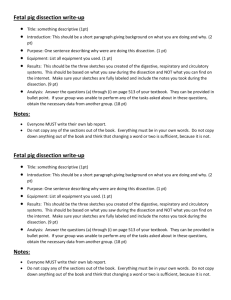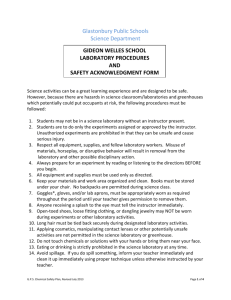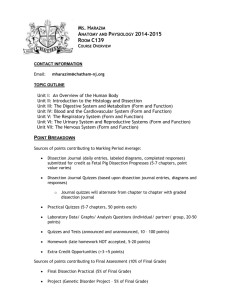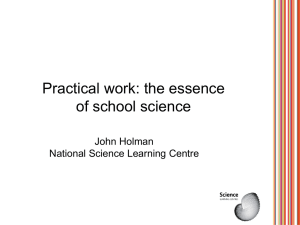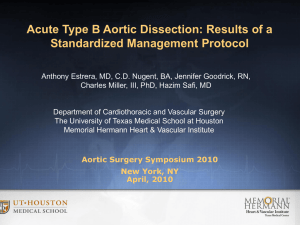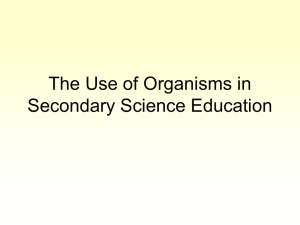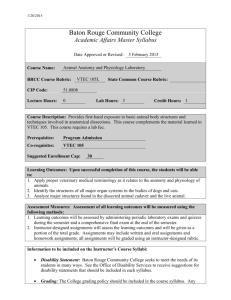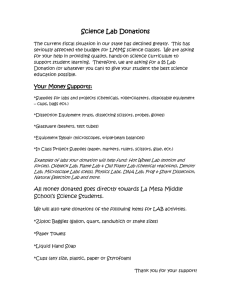Abby Soltis ED 433 March 21, 2012 Humane and ethical treatment
advertisement
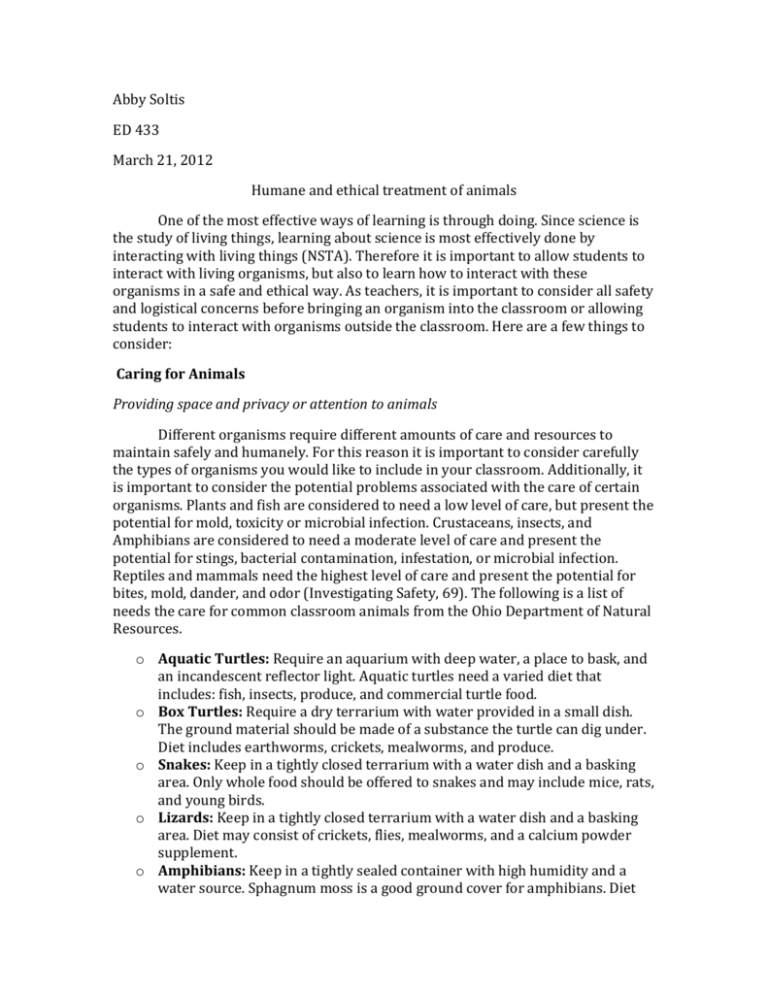
Abby Soltis ED 433 March 21, 2012 Humane and ethical treatment of animals One of the most effective ways of learning is through doing. Since science is the study of living things, learning about science is most effectively done by interacting with living things (NSTA). Therefore it is important to allow students to interact with living organisms, but also to learn how to interact with these organisms in a safe and ethical way. As teachers, it is important to consider all safety and logistical concerns before bringing an organism into the classroom or allowing students to interact with organisms outside the classroom. Here are a few things to consider: Caring for Animals Providing space and privacy or attention to animals Different organisms require different amounts of care and resources to maintain safely and humanely. For this reason it is important to consider carefully the types of organisms you would like to include in your classroom. Additionally, it is important to consider the potential problems associated with the care of certain organisms. Plants and fish are considered to need a low level of care, but present the potential for mold, toxicity or microbial infection. Crustaceans, insects, and Amphibians are considered to need a moderate level of care and present the potential for stings, bacterial contamination, infestation, or microbial infection. Reptiles and mammals need the highest level of care and present the potential for bites, mold, dander, and odor (Investigating Safety, 69). The following is a list of needs the care for common classroom animals from the Ohio Department of Natural Resources. o Aquatic Turtles: Require an aquarium with deep water, a place to bask, and an incandescent reflector light. Aquatic turtles need a varied diet that includes: fish, insects, produce, and commercial turtle food. o Box Turtles: Require a dry terrarium with water provided in a small dish. The ground material should be made of a substance the turtle can dig under. Diet includes earthworms, crickets, mealworms, and produce. o Snakes: Keep in a tightly closed terrarium with a water dish and a basking area. Only whole food should be offered to snakes and may include mice, rats, and young birds. o Lizards: Keep in a tightly closed terrarium with a water dish and a basking area. Diet may consist of crickets, flies, mealworms, and a calcium powder supplement. o Amphibians: Keep in a tightly sealed container with high humidity and a water source. Sphagnum moss is a good ground cover for amphibians. Diet should include earthworms and crickets. Sick animals and providing medical attention When bringing animals into the classroom it is important to consider the types disease or allergens an animal can carry and also know what to do in the case of a sick animal. Students should never handle a sick animal and the animal should most likely be taken to a veterinarian. A plan should be set in place in the event that an animal becomes sick (Investigating Safety). Student Rules Rules for student interaction with living things As a future biology teacher I believe that it is important to provide students with not only knowledge about living things, but also a respect for those living things. The best way to do this is to maintain strict rules for the care of living this, whether the organism is a plant, insect or mammal. Rules to prevent students from becoming ill from exposure to toxins or disease-causing organisms In order to insure that students do not become ill from exposure to animals, it is important to follow the rules for handling animals and remove or get care for sick animals immediately. Students should wash hands with soap and hot water after handling. It is also important to note student allergies to prevent health problems. Do not bring in exotic plants or animals as they have the potential to carry harmful pathogens. It is also important to note that plants in the field may be harmful to students as well, causing allergic reactions (investigating Safety). Laws Restriction of experimentation Before experimenting with living organisms or tissues it is important to recognize the risks involved. It is no longer recommended that human tissue (check cells, saliva, blood, etc.) be used in the classroom. Also, many reagents that once were common in the classroom are no longer recommended to toxicity (PTC tasting strips, Methyl Red, etc.). Additionally, certain types of bacteria once common in the classroom should not be used such as Serratia marcenes (Investigating Safety). Restrictions on the collection of living things or materials from nature Before collecting things from nature it is important to know what is being brought into the classroom. Plants species should be checked for toxicity and care should be taken to avoid poison oak and ivy in the field. Exotic and invasive species should also be kept away from the outside environment. Before disturbing the environment or collecting wild specimens, ask yourself if the same educational goals can be met in a different way. If organisms are collected it is important to check with the Department of Natural Resources and obtain a permit if needed. Some states offer education permits for classroom collection (Ohio DNR). Cautions and laws on the use of preserved animals and use of living materials The National Science Teachers Association addresses the use of preserved animals in their positions statement: “NSTA recognizes science educators as professionals. As such, they are in the best position to determine when to use—or not use—dissection activities. NSTA encourages teachers to be sensitive to students’ views regarding dissection, and to be aware of students’ beliefs and their right to make an informed decision about their participation. Teachers, especially those at the primary level, should be especially cognizant of students’ ages and maturity levels when deciding whether to use animal dissection. Should a teacher feel that an alternative to dissection would be a better option for a student or group of students, it is important that the teacher select a meaningful alternative.” Currently, there are no laws in Indiana regarding the use of animals for dissection in the classroom, however there are 10 states that do have such legislation (Animalearn). While it is not required in Indiana to offer an alternative to dissection, I would likely offer one if the student (or parents) could present a better reason than “it’s gross.” Another consideration for dissecting in the classroom is safety. The sharp instruments used for dissection can be a danger to students, so it is important to carefully gauge student maturity before a dissection. Also, it is important to consider the type of preservative used. Choose the preservative for the lowest toxicity and keep the MSDS data sheet on hand. Also, do not keep solution or animals after dissection because mold will likely grow. Students should wear eye protection and gloves (Investigating Safety). Alternatives to the use of preserved animals for dissection While the National Science Teachers Association encourages teacher choice in the use of preserved animals for dissection, other alternatives are also offered. Many textbooks now offer virtual dissections as a part of the online supplement, however there are also other virtual dissection programs available. Another alternative is to use fresh grocery materials such as chicken wings or beef hearts (Investigating Safety). PETA recommends the following: o The Digital Frog is a fully interactive CD-ROM that allows students to explore the frog through three seamlessly linked modules— dissection, anatomy, and ecology. o DryLab Suite features detailed, computer-based dissection simulations to study the anatomy of frogs, earthworms, rats, fetal pigs, crayfish, and perch. o Anatomy in Clay allows students to build the body systems of humans and animals out of clay on model skeletons. o DissectionWorks comprises five interactive, computer-dissection simulations, including those of a frog, crayfish, perch, and fetal pig. A digital cat dissection with detailed graphics and information is also available. o Body Works offers a fascinating computer program that explores the body’s systems, structure, and functions. o Sniffy the Virtual Rat is a unique computer program that allows students to explore the principles of operant psychology using a “virtual rat.” o CatLab is a fully interactive, multimedia dissection of a cat. o Great American Bullfrog is a large-scale model with numbered parts and a key card; circulatory, reproductive, and other systems can be separately dissected. o Biology Chart Series includes detailed charts of a dissected frog, perch, crayfish, grasshopper, earthworm, etc. Resources Animalearn: http://www.animalearn.org/elementaryLaws.php#in National Science Teacher Association: nsta.org National Science Teacher Association: Investigating safety Ohio Department of Natural Resources: A guide to using animals in the classroom. People for the Ethical Treatment of Animals: http://www.peta.org/issues/animalsused-for-experimentation/dissection-lessons-in-cruelty.aspx
